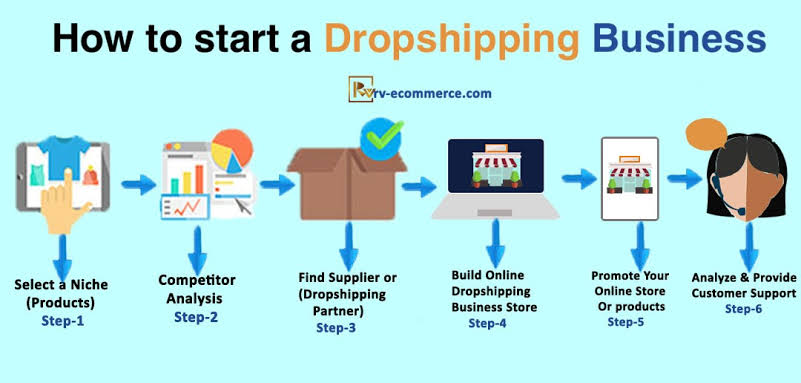- Starting a dropshipping business is a popular and effective way to enter the world of e-commerce without the need for significant upfront investment. It allows you to sell products without holding inventory or managing fulfillment. If done correctly, dropshipping can lead to a profitable business model. In this article, we will walk you through the essential steps to starting a successful dropshipping business.
1. Understanding Dropshipping:
Before you dive into the process, it’s crucial to fully understand the dropshipping business model. Dropshipping is a retail fulfillment method where the store doesn’t keep the products it sells in stock. Instead, when you make a sale, the product is purchased from a third party—usually a supplier or wholesaler—who then ships it directly to the customer. You, the retailer, never handle the product directly.
The main benefits of dropshipping include low startup costs, reduced risk, and the ability to run your business from anywhere. However, it also comes with challenges such as high competition and lower profit margins.
2. Choose a Profitable Niche:
Selecting the right niche is critical to the success of your dropshipping business. A niche is a specific segment of the market that you will focus on. Choosing the right niche can make or break your business.
Do Market Research: Research various industries and find products with high demand and low competition. You can use tools like Google Trends, Amazon, or eBay to identify trends and popular products.
products with high demand and low competition. You can use tools like Google Trends, Amazon, or eBay to identify trends and popular products.
Focus on Passionate Audiences: It’s easier to market products to a group of people who are passionate about a specific topic. For example, pet lovers or fitness enthusiasts are always looking for the latest products related to their interests.
Consider Profit Margins: Make sure the products you choose offer good profit margins. Since you’ll be paying a supplier for the product and shipping, aim for products that give you enough room to earn a profit after covering these costs.
3. Find Reliable Suppliers:
Finding reliable suppliers is crucial to the success of your dropshipping business. A trustworthy supplier ensures timely shipping, high-quality products, and excellent customer service, which are all vital for maintaining a good reputation.
Start by using well-known platforms like AliExpress, Oberlo, or SaleHoo to find suppliers. These platforms offer a wide range of products, often at competitive prices, making it easier to source items for your store.
It’s important to check supplier reviews and ratings before making a commitment. Look for feedback from other dropshippers to assess the supplier’s reliability, product quality, and overall customer satisfaction. A supplier with a consistent history of poor service or negative reviews can harm your business in the long run.
Additionally, always place test orders. This step is essential to evaluate the product’s quality, shipping speed, and the supplier’s customer service firsthand. By testing the order process before launching your store, you’ll be able to identify any issues early on, ensuring a smoother experience for your customers once you begin selling.
4. Set Up an E-Commerce Website
To start selling products, you need an online store. Platforms like Shopify, WooCommerce (on WordPress), or BigCommerce make it easy to create an e-commerce site without any technical expertise.
Choose a Platform: Shopify is one of the most popular platforms for dropshipping businesses due to its simplicity, ease of use, and a vast array of integrated tools and apps. WooCommerce, while a bit more complex, offers flexibility if you want to build your store on WordPress.
Design Your Website: The design of your website plays a significant role in user experience and conversion rates. Make sure your website is easy to navigate, mobile-friendly, and visually appealing. You can choose from a range of themes or hire a designer if necessary.
Set Up Payment Processing: Set up payment gateways such as PayPal, Stripe, or credit card payments to make it easy for customers to purchase from your store.
5. Market Your Store:
Marketing is essential to drive traffic to your store and convert visitors into paying customers. As a dropshipper, you need to stand out in a competitive market.
Social Media Marketing: Platforms like Instagram, Facebook, and TikTok are great places to market your dropshipping products. Create engaging posts, collaborate with influencers, or run paid ads to get your products in front of the right audience.
Search Engine Optimization (SEO): Optimize your website for search engines to attract organic traffic. Use relevant keywords in your product descriptions, blog posts, and meta tags to increase your chances of ranking higher in search results.
Email Marketing: Build an email list to stay in touch with your customers and encourage repeat sales. You can offer discounts, promotions, or valuable content to keep your audience engaged.
Paid Advertising: Google Ads and Facebook Ads are popular choices for dropshipping businesses. Set up targeted ad campaigns to reach potential customers who are interested in your niche.
6. Customer Service and Retention:
Providing excellent customer service is key to retaining customers and growing your dropshipping business. Responding promptly to inquiries, addressing issues, and offering a hassle-free return policy will help you build trust and loyalty with your customers.
Track Orders: Make sure to keep customers updated on their order status. Tracking numbers and timely notifications will reduce anxiety and enhance the customer experience.
Resolve Issues Quickly: If a customer has an issue, resolve it as quickly and professionally as possible. A customer’s experience with your support team can determine whether they return or leave negative feedback.
Encourage Reviews and Referrals: After a successful transaction, ask your satisfied customers for reviews. Positive reviews can help build trust and improve your reputation.
7. Optimize and Scale Your Business:
Once your dropshipping business is running, it’s important to continuously optimize and scale it. Monitor performance through analytics, track your sales, and adjust marketing strategies as needed.
Use Analytics Tools: Tools like Google Analytics can help you track customer behavior, identify high-converting products, and adjust your strategy accordingly.
Automate Processes: As your business grows, consider automating tasks such as order processing, email marketing, and social media posting. This will save you time and allow you to focus on scaling your business.
Expand Your Product Range: Once you find success with your initial products, consider expanding your product range or introducing new variations to attract a wider audience.
Conclusion:
Starting a successful dropshipping business requires careful planning, research, and strategy. By choosing the right niche, working with reliable suppliers, setting up an attractive e-commerce website, and implementing strong marketing techniques, you can build a thriving dropshipping business. Remember that success won’t happen overnight, but with dedication and consistency, you can scale your business and enjoy a sustainable income. Stay focused, keep learning, and continue to refine your business practices to stay ahead in the competitive dropshipping market.








